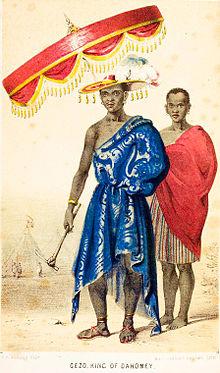Ghezo
Ghezo, tí sípẹ́lì rẹ̀ tún jẹ́ Gezo, jẹ́ ọba ilẹ̀ Dahomey, (èyí tó ti di ìlú Benin báyìí) láti ọdụ́n1818 títí wọ 1859. Ghezo rọ́pò ẹ̀gbọ́n rẹ̀ tí ń jẹ́ Adandozan (tó jọba láti ọdún 1797 títí wọ ọdún 1818) gẹ́gẹ́ bí i ọba látàri ìsọ̀tè tó wáyé pẹ̀lú ìànlọ́wọ́ àwọn olówò ẹrú ilẹ̀ Brasil, ìyẹn Francisco Félix de Sousa. Ó jọba lóri ìlú náà lásìkò tí rúdurùdu gbilẹ̀ ní ilẹ̀ náà, pẹ̀lú ìdíwọ àwọn èbúté lóríṣiríṣi tó ti ọwọ́ àwọn aláwọ̀ funfun wá, láti dẹ́kun Atlantic slave trade.[1]
| Ghezo | |
|---|---|
| King of Dahomey
| |

| |
| A depiction of King Ghezo in a 1851 publication | |
| Reign | 1818–1859 |
| Predecessor | Adandozan |
| Successor | Glele |
| Father | Agonglo |
| Died | 1859 |

Ghezo ló fòpin sí sísan ìṣákọọ́lẹ̀ sí Oyo Empire.[2] It is quite likely that the initial struggle was more violent than this story relates.[3] Lẹ́yìn náà, ó gbógun ti ọ̀pọ̀lọpọ̀ olówò ẹrú, ní ìbámu láti dẹ́kùn òwò náà. Wọ́n pa Ghezo ní ọdún 1859, ọmọ rè Glele sì jọba.
Àwọn ìtọ́kasí
àtúnṣe- ↑ Bay, Edna G. (1998). Wives of the Leopard: Gender, Politics, and Culture in the Kingdom of Dahomey. University of Virginia Press. ISBN 0-8139-1792-1.
- ↑ Akinjogbin, I.A. (1967). Dahomey and Its Neighbors: 1708-1818. Cambridge University Press.
- ↑ Àṣìṣe ìtọ́kasí: Invalid
<ref>tag; no text was provided for refs namedBay2